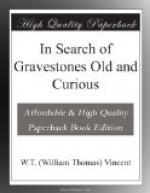CHAPTER II.
The evolution of gravestones.
Although there may be no expectation of discovering the germ of the pictorial or allegorical gravestone, a section of the samples collected for this essay may be displayed to shew the earlier forms in which the ruder class of masons prepared their sculptured monuments for the churchyard. There is little doubt that the practice originated in an endeavour to imitate on the common gravestone the nobler memorials of the churches and cathedrals, the effort being more or less successful in proportion to the individual skill of the artist. The influence of locality, however, must always be a factor in this consideration; for, as a rule, it will be found that the poorest examples come from essentially secluded places, while localities of earlier enlightenment furnish really admirable work of much prior date. Take, for instance, that most frequent emblem, the skull. I have not sought for the model by which the village sculptor worked, but I have in my note-book this sketch of a skull, copied from a sixteenth-century tomb at Frankfort on the Maine, and there are doubtless a vast number equal to it in English cathedrals and churches of the same period.
Fig. 9.—At Frankfort, Germany.
Regarding this as our ideal, the primitive work which we find in rural localities must be pronounced degenerated art. Generally speaking we may assume that the carver of the stately tomb within the church had no hand in the execution of the outer gravestone; but that quite early there were able masons employed upon the decoration of the churchyard headstone is shewn in many instances, of which the one presented in Fig. 10 may serve as a very early specimen.
Fig. 10.—At East Wickham.
“To Eliza and Lydia, the two wives
of Anthony
Neighbours, died
18th Nov. 1675 and 11th
March 1702.”
The dates are remarkable in connection with such an elaborate work. East Wickham is little more than a village even now, and this carving is very creditable in comparison with other attempts of the same early period; but the high road from London to Dover runs through the parish, and may have carried early cultivation into the district. All the rougher illustrations which I have found have been in remote and isolated spots, or spots that were remote and isolated when the stones were set up. The first of these which I discovered was in the little churchyard of Ridley in Kent, “far from the haunts of men.”




